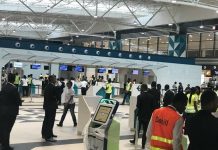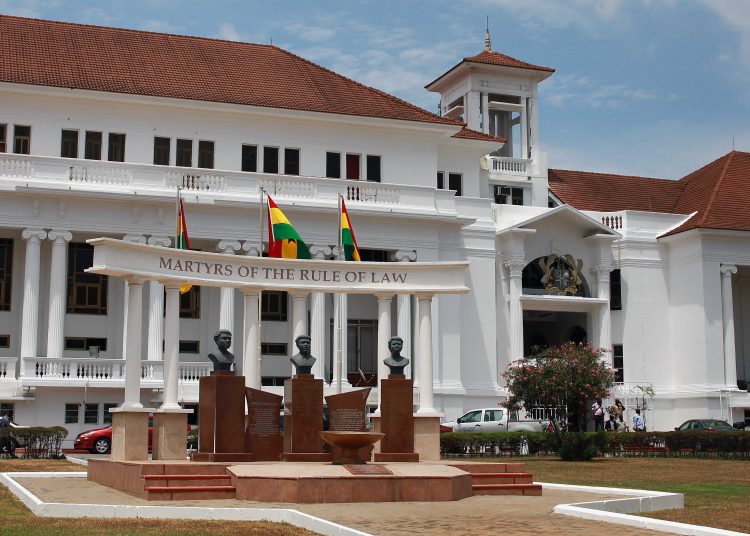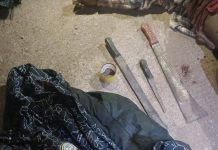
Hours after it reported an “accident” at its Natanz nuclear complex, and said there were no casualties or radioactive pollution, Iran on Thursday warned that it would weigh its response to “hostile countries” including Israel and the US if they had crossed Iran’s “red lines in any way.”
Iran initially downplayed Thursday morning’s events at Netanz, initially claiming vaguely there had been an unspecified “incident” and later acknowledging a fire.
Later it elaborated on what it still called an accident, and issued assurances that there was no danger of radioactive fallout, but it subsequently also issued a warning to its foes.
US-based analysts said the building, located above Iran’s underground Natanz enrichment facility, was a new centrifuge production plant and that it was hit by a fire and an explosion.
Asked about reports of the incident at a press conference Thursday evening, Israel’s Prime Minister Benjamin Netanyahu brushed aside the question: “I don’t address these issues,” he said.

A fire has burned a building above Iran’s underground Natanz nuclear enrichment facility, though officials say it did not affect its centrifuge operation or cause any release of radiation.;
The site of the fire corresponds to a newly opened centrifuge production facility, said Fabian Hinz, a researcher at the James Martin Center for Nonproliferation Studies at the Middlebury Institute of International Studies in Monterey, California. He said he relied on satellite images and a state TV program on the facility to locate the building, which sits in Natanz’s northwest corner.
David Albright of the Institute for Science and International Security similarly said the fire struck the production facility. His institute previously wrote a report on the new plant, identifying it from satellite pictures while it was under construction and later built.
There was “no nuclear material [at the building] and no potential of pollution,” the spokesman for Iran’s Atomic Energy Organization Behrouz Kamalvandi told state television. Kamalvandi said no radioactive material or personnel were present.
He noted that the cause was being investigated, and said the fire had led to “some structural damage.”
READ ALSO: More than 80 killed after protest singer’s assassination
READ ALSO: Gabon fires back as it bans entry to European travellers
READ ALSO: Landslide kills over 100 miners in Myanmar
There was “no interruption to the work of the enrichment site itself,” which “is working at the pace it used to,” Kamalvandi said.
Hours after the announcement, Iran’s state news agency IRNA published an editorial warning that “if there are signs of hostile countries crossing Iran’s red lines in any way, especially the Zionist regime (Israel) and the United States, Iran’s strategy to confront the new situation must be fundamentally reconsidered.”
IRNA also reported that unnamed Israeli social media accounts had claimed the Jewish state was responsible for the “sabotage attempts.”
It stressed that Iran had tried “to prevent escalations and unpredictable situations while defending its position and national interests”.
The BBC’s Persian service, which Iranian authorities consider hostile, said it received a statement “hours before” the accident from a group called the “Homeland Cheetahs” who claimed responsibility for the accident.
They claimed to be “dissidents present in Iran’s security apparatuses” and said the location was targeted as it was not “underground” and therefore the alleged attack could not be denied.
Iran’s nuclear body has yet to provide a formal explanation for the incident.
An unnamed former Iranian nuclear official told Reuters that sabotage was a possibility. “Considering that this so-called incident happened just a few days after the explosion near the Parchin military base, the possibility of a sabotage cannot be ruled out,” this source said. “Also Natanz enrichment facility has been targeted in the past by a computer virus,” he added, referring to Stuxnet.
But Tehran-based analyst Mohammad Marandi ridiculed claims of responsibility for the accident on Twitter.
“If there’s a fire anywhere, Iran’s foes claim a military strike,” said Marandi, who heads the American studies department at Tehran University.
“BBC Persian claims sabotage by a secret organization, while their brethren in Israeli propaganda claim a drone strike! Poor coordination.”
The Iranian Atomic Energy Organization released a photo purportedly from the site, showing a one-story building with a damaged roof, walls apparently blackened by fire and doors hanging off their hinges as if blown out from the inside.
State TV later showed a different angle of the building with minor damage to its walls and some of its fans still working.
Natanz governor Ramezan-Ali Ferdowsi told the Tasnim news agency that a fire had broken out at the warehouse.






















































![[FREE FREE MONEY] Predict and Win a Guaranteed GH¢200 From Us EVERY WEEK](https://wordpress.ghanatalksradio.com/wp-content/uploads/2022/02/Predict-and-Win-Final-09-03-2021-218x150.jpg)
![[Predict & Win – 8th/Oct.] WIN A Guaranteed ¢200 From Us This Week](https://wordpress.ghanatalksradio.com/wp-content/uploads/2021/10/maxresdefault-16-218x150.jpg)
![[Predict & Win – 2nd] WIN A Guaranteed ¢200 From Us This Week](https://wordpress.ghanatalksradio.com/wp-content/uploads/2021/09/maxresdefault-50-218x150.jpg)
![[Predict & Win – 25th] WIN A Guaranteed ¢200 From Us This Week](https://wordpress.ghanatalksradio.com/wp-content/uploads/2021/09/maxresdefault-36-218x150.jpg)
![[Predict & Win – 18th] WIN A Guaranteed ¢200 From Us This Week](https://wordpress.ghanatalksradio.com/wp-content/uploads/2021/09/maxresdefault-23-218x150.jpg)









![[National cathedral] See full list of churches that have contributed since 2018](https://wordpress.ghanatalksradio.com/wp-content/uploads/2020/09/Ghana-National-Cathedral-GhanaTalksRadio-100x70.jpg)



